A Novel Method for Carbendazim High-Sensitivity Detection Based on the Combination of Metamaterial Sensor and Machine Learning
Abstract
:1. Introduction
2. Materials and Methods
2.1. Samples Preparation
2.2. Metamaterial sensor Structure and Simulation
2.3. Mean Shift
| Algorithm 1 Mean shift |
| Input: data, bandwidth |
| Output: labels |
| 1: Choose a point at random as the initial center point. |
| 2: Find all points whose distance from the center point is less than the bandwidth, denoted as set S, and consider these points as belonging to cluster C. |
| 3: Calculate the vectors starting from the center point to each element in the set S. Add these vectors to get the mean shift . |
| 4: Calculate the center point:. |
| 5: Repeat steps 2–4 until ( is a threshold). |
| 6: If the distance between the center point of cluster C converges and the center point of other clusters is less than the threshold, the two clusters are merged. Otherwise, list C as a separate new cluster. |
| 7: Repeat steps 1–6 until all points have been marked. |
| 8: return labels |
2.4. Spectral Measurements
3. Results and Discussion
3.1. Analysis of Simulation Results
3.2. Analysis of Experiment Results
| Method | Limit of Detection |
|---|---|
| Ma et al. Ref [28] | 50% (Mass fraction) |
| Cao et al. Ref [26] | 2.5% (Mass fraction) |
| Qin et al. Ref [29] | 2.5% (Mass fraction) |
| Yang et al. Ref [37] | 2% (Mass fraction) |
| Qin et al. Ref [33] | 5 mg/L |
| Nie et al. Ref [42] | 10 mg/L |
| Our proposed method | 0.5 mg/L |
4. Conclusions
Author Contributions
Funding
Data Availability Statement
Conflicts of Interest
References
- Kara, M.; Oztas, E.; Ramazanoullar, R.; Kouretas, D.; Veskoukis, A.S. Benomyl, a benzimidazole fungicide, induces oxidative stress and apoptosis in neural cells. Toxicol. Rep. 2020, 7, 501–509. [Google Scholar] [CrossRef] [PubMed]
- Aire, T.A. Short-term effects of carbendazim on the gross and microscopic features of the testes of Japanese quails (Coturnix coturnix japonica). Anat. Embryol. 2005, 210, 43–49. [Google Scholar] [CrossRef] [PubMed]
- Zq, A.; Yj, A.; Hp, A.; Jl, A.; St, B.; Pm, A.; Xw, A.; Ds, A.; Ying, S.A. MIL-101(Cr)/MWCNTs-functionalized melamine sponges for solid-phase extraction of triazines from corn samples, and their subsequent determination by HPLC-MS/MS—ScienceDirect. Talanta 2020, 211, 120676. [Google Scholar] [CrossRef]
- Attig, J.B.; Latrous, L.; Zougagh, M.; Rios, N. Ionic liquid and magnetic multiwalled carbon nanotubes for extraction of N-methylcarbamate pesticides from water samples prior their determination by capillary electrophoresis. Talanta 2021, 226, 122106. [Google Scholar] [CrossRef] [PubMed]
- Harshit, D.; Charmy, K.; Nrupesh, P. Organophosphorus pesticides determination by novel HPLC and spectrophotometric method. Food Chem. 2017, 230, 448–453. [Google Scholar] [CrossRef]
- Barbieri, M.V.; Postigo, C.; Guillem-Argiles, N.; Monllor-Alcaraz, L.S.; Simionato, J.I.; Stella, E.; Barcelo, D.; Miren, L. Analysis of 52 pesticides in fresh fish muscle by QuEChERS extraction followed by LC-MS/MS determination. Sci. Total Environ. 2019, 653, 958–967. [Google Scholar] [CrossRef] [PubMed]
- Qu, F.; Lin, L.; Cai, C.; Chu, B.; Nie, P. Terahertz fingerprint characterization of 2,4-dichlorophenoxyacetic acid and its enhanced detection in food matrices combined with spectral baseline correction. Food Chem. 2020, 334, 127474. [Google Scholar] [CrossRef] [PubMed]
- Yao, T.; Liu, A.; Liu, Y.; Wei, M.; Liu, S. Ratiometric fluorescence sensor for organophosphorus pesticide detection based on opposite responses of two fluorescence reagents to MnO2 nanosheets. Biosens. Bioelectron. 2019, 145, 111705. [Google Scholar] [CrossRef]
- Tao, Z.; Deng, J.; Wang, Y.; Chen, H.; Wang, M. Competitive immunoassay for simultaneous detection of imidacloprid and thiacloprid by upconversion nanoparticles and magnetic nanoparticles. Environ. Sci. Pollut. Res. 2019, 26, 23471–23479. [Google Scholar] [CrossRef]
- Fra, C.; Alo, B.; Naab, B.; Mmea, C.; Cva, C. Bioactive microfluidic paper device for pesticide determination in waters. Talanta 2020, 218, 121108. [Google Scholar] [CrossRef]
- Verma, N.; Bhardwaj, A. Biosensor Technology for Pesticides-A review. Appl. Biochem. Biotechnol. 2015, 175, 3093–3119. [Google Scholar] [CrossRef] [PubMed]
- Zhu, J.; Sharma, A.S.; Xu, J.; Xu, Y.; Chen, Q. Rapid on-site identification of pesticide residues in tea by one-dimensional convolutional neural network coupled with surface-enhanced Raman scattering. Spectrochim. Acta Part A Mol. Biomol. Spectrosc. 2021, 246, 118994. [Google Scholar] [CrossRef] [PubMed]
- Zhu, J.; Ahmad, W.; Xu, Y.; Liu, S.; Chen, Q.; Hassan, M.M. Development of a novel wavelength selection method for the trace determination of chlorpyrifos on Au@Ag NPs substrate coupled surface-enhanced Raman spectroscopy. Analyst 2018, 144, 1167–1177. [Google Scholar] [CrossRef] [PubMed]
- Lu, Y.; Li, X.; Li, W.; Shen, T.; Liu, F. Detection of chlorpyrifos and carbendazim residues in the cabbage using visible/near-infrared spectroscopy combined with chemometrics. Spectrochim. Acta Part A Mol. Biomol. Spectrosc. 2021, 257, 119759. [Google Scholar] [CrossRef] [PubMed]
- Mikac, L.; Kovaevi, E.; Uki, S.; Rai, M.; Ivanda, M. Detection of Multi-class Pesticide Residues with Surface-Enhanced Raman Spectroscopy. Spectrochim. Acta Part A Mol. Biomol. Spectrosc. 2021, 252, 119478. [Google Scholar] [CrossRef]
- Pham, T.B.; Hoang, T.; Pham, V.H.; Nguyen, V.C.; Nguyen, T.V.; Vu, D.C.; Pham, V.H.; Bui, H. Detection of Permethrin pesticide using silver nano-dendrites SERS on optical fibre fabricated by laser-assisted photochemical method. Sci. Rep. 2019, 9, 12590. [Google Scholar] [CrossRef]
- Zhang, Q.; Li, D.; Cao, X.; Gu, H.; Deng, W. Self-Assembled Microgels Arrays for Electrostatic Concentration and Surface-Enhanced Raman Spectroscopy Detection of Charged Pesticides in Seawater. Anal. Chem. 2019, 91, 11192–11199. [Google Scholar] [CrossRef]
- Gong, X.; Tang, M.; Gong, Z.; Qiu, Z.; Wang, D.; Fan, M. Screening pesticide residues on fruit peels using portable Raman spectrometer combined with adhesive tape sampling. Food Chem. 2019, 295, 254–258. [Google Scholar] [CrossRef]
- Madianos, L.; Skotadis, E.; Patsiouras, L.; Filippidou, M.K.; Chatzandroulis, S.; Tsoukalas, D. Nanoparticle based gas-sensing array for pesticide detection. J. Environ. Chem. Eng. 2018, 6, 6641–6646. [Google Scholar] [CrossRef]
- Chen, J.; Huang, M.; Kong, L. Flexible Ag/Nanocellulose fibers SERS substrate and its applications for in-situ hazardous residues detection on food. Appl. Surf. Sci. 2020, 533, 147454. [Google Scholar] [CrossRef]
- Xu, W.; Wang, S.; Li, W.; Zhang, Z.; Wang, Y.; Yang, Y.; Zhang, H.; Liu, P.; Xie, L.; Ying, Y. Pesticide detection with covalent-organic-framework nanofilms at terahertz band. Biosens. Bioelectron. 2022, 209, 114274. [Google Scholar] [CrossRef] [PubMed]
- Tu, S.; Wang, Z.; Zhang, W.; Li, Y.; She, Y.; Du, H.; Yi, C.; Qin, B.; Liu, Z. A new technology for rapid determination of isomers of hydroxybenzoic acid by terahertz spectroscopy. Spectrochim. Acta Part A Mol. Biomol. Spectrosc. 2022, 279, 121313. [Google Scholar] [CrossRef] [PubMed]
- Li, F.; Zhang, J.; Wang, Y. Vibrational spectroscopy combined with chemometrics in authentication of functional foods. Crit. Rev. Anal. Chem. 2022, 9, 1–22. [Google Scholar] [CrossRef] [PubMed]
- Huo, Z.; Zhi, L.I.; Tao, C.; Qin, B. Quantitative determination of Auramine O by terahertz spectroscopy with 2DCOS-PLSRmodel. Spectrochim. Acta A Mol. Biomol. Spectrosc. 2017, 184, 335–341. [Google Scholar]
- Chen, Q.; Jia, S.; Qin, J.; Du, Y.; Zhao, Z. A Feasible Approach to Detect Pesticides in Food Samples Using THz-FDS and Chemometrics. J. Spectrosc. 2020, 2020, 1–10. [Google Scholar] [CrossRef]
- Cao, B.; Li, H.; Fan, M.; Wang, W.; Wang, M. Determination of pesticides in a flour substrate by chemometric methods using terahertz spectroscopy. Anal. Methods 2018, 10, 5097–5104. [Google Scholar] [CrossRef]
- Liu, L.; Hu, P.; Yang, F.; Song, M. Application of terahertz time-domain spectroscopy combined with support vector machine to determine tea and pesticide samples. Mater. Express 2020, 10, 1646–1653. [Google Scholar] [CrossRef]
- Ma, Y.; Qiang, W.; Wang, X.; Wang, H. Research of pesticide residues on fruit by terahertz spectroscopy technology. Proc. SPIE-Int. Soc. Opt. Eng. 2011, 8201, 67. [Google Scholar]
- Qin, B.; Li, Z.; Luo, Z.; Li, Y.; Zhang, H. Terahertz time-domain spectroscopy combined with PCA-CFSFDP applied for pesticide detection. Opt. Quantum Electron. 2017, 49, 244.1–244.12. [Google Scholar] [CrossRef]
- Xu, W.; Xu, W.; Xie, L.; Xie, L.; Ying, Y.; Ying, Y. Mechanisms and applications of terahertz metamaterial sensing: A review. Nanoscale-Cambridge 2017, 9, 13864–13878. [Google Scholar] [CrossRef]
- Xie, L.; Gao, W.; Shu, J.; Ying, Y.; Kono, J. Extraordinary sensitivity enhancement by metasurfaces in terahertz detection of antibiotics. Sci. Rep. 2015, 5, 8671. [Google Scholar] [CrossRef] [PubMed]
- Qin, J.; Xie, L.; Ying, Y. A high-sensitivity terahertz spectroscopy technology for tetracycline hydrochloride detection using metamaterials. Food Chem. 2016, 211, 300–305. [Google Scholar] [CrossRef] [PubMed]
- Qin, B.; Li, Z.; Hu, F.; Hu, C.; Chen, T.; Zhang, H.; Zhao, Y. Highly Sensitive Detection of Carbendazim by Using Terahertz Time-Domain Spectroscopy Combined With Metamaterial. IEEE Trans. Terahertz. Sci. Technol. 2018, 8, 149–154. [Google Scholar] [CrossRef]
- Yang, S.; Li, C.; Mei, Y.; Liu, W.; Xu, K. Determination of the Geographical Origin of Coffee Beans Using Terahertz Spectroscopy Combined With Machine Learning Methods. Front. Nutr. 2021, 8, 680627. [Google Scholar] [CrossRef] [PubMed]
- Silva, V.H.D.; Vieira, F.S.; Rohwedder, J.J.R.; Pasquini, C.; Pereira, C.F. Multivariate quantification of mebendazole polymorphs by terahertz time domain spectroscopy (THz-TDS). Analyst 2017, 142. [Google Scholar] [CrossRef]
- Wang, B.; Qin, X.; Meng, K.; Zhu, L.; Li, Z. Classification of Amino Acids Using Hybrid Terahertz Spectrum and an Efficient Channel Attention Convolutional Neural Network. Nanomaterials 2022, 12, 2114. [Google Scholar] [CrossRef]
- Yang, R.; Li, Y.; Qin, B.; Zhao, D.; Gan, Y.; Zheng, J. Pesticide detection combining the Wasserstein generative adversarial network and the residual neural network based on terahertz spectroscopy. RSC Adv. 2022, 12, 1769–1776. [Google Scholar] [CrossRef]
- Fukunaga, K.; Hostetler, L. The estimation of the gradient of a density function, with applications in pattern recognition. IEEE Trans. Inf. Theory 1975, 21, 32–40. [Google Scholar] [CrossRef]
- Cheng, Y. Mean shift, mode seeking, and clustering. IEEE Trans. Pattern. Anal. Mach. Intell. 1995, 17, 790–799. [Google Scholar] [CrossRef]
- O’Hara, J.F.; Singh, R.; Brener, I.; Smirnova, E.; Zhang, W. Thin-film sensing with planar terahertz metamaterials: Sensitivity and limitations. Opt. Express 2008, 16, 1786–1795. [Google Scholar] [CrossRef]
- Chen, T.; Li, Z.; Mo, W. Identification of biomolecules by terahertz spectroscopy and fuzzy pattern recognition. Spectrochim. Acta Part A Mol. Biomol. Spectrosc. 2013, 106, 48–53. [Google Scholar] [CrossRef] [PubMed]
- Nie, P.; Qu, F.; Lin, L.; He, Y.; Feng, X.; Yang, L.; Gao, H.; Zhao, L.; Huang, L. Trace Identification and Visualization of Multiple Benzimidazole Pesticide Residues on Toona sinensis Leaves Using Terahertz Imaging Combined with Deep Learning. Int. J. Mol. Sci. 2021, 7, 3425. [Google Scholar] [CrossRef] [PubMed]



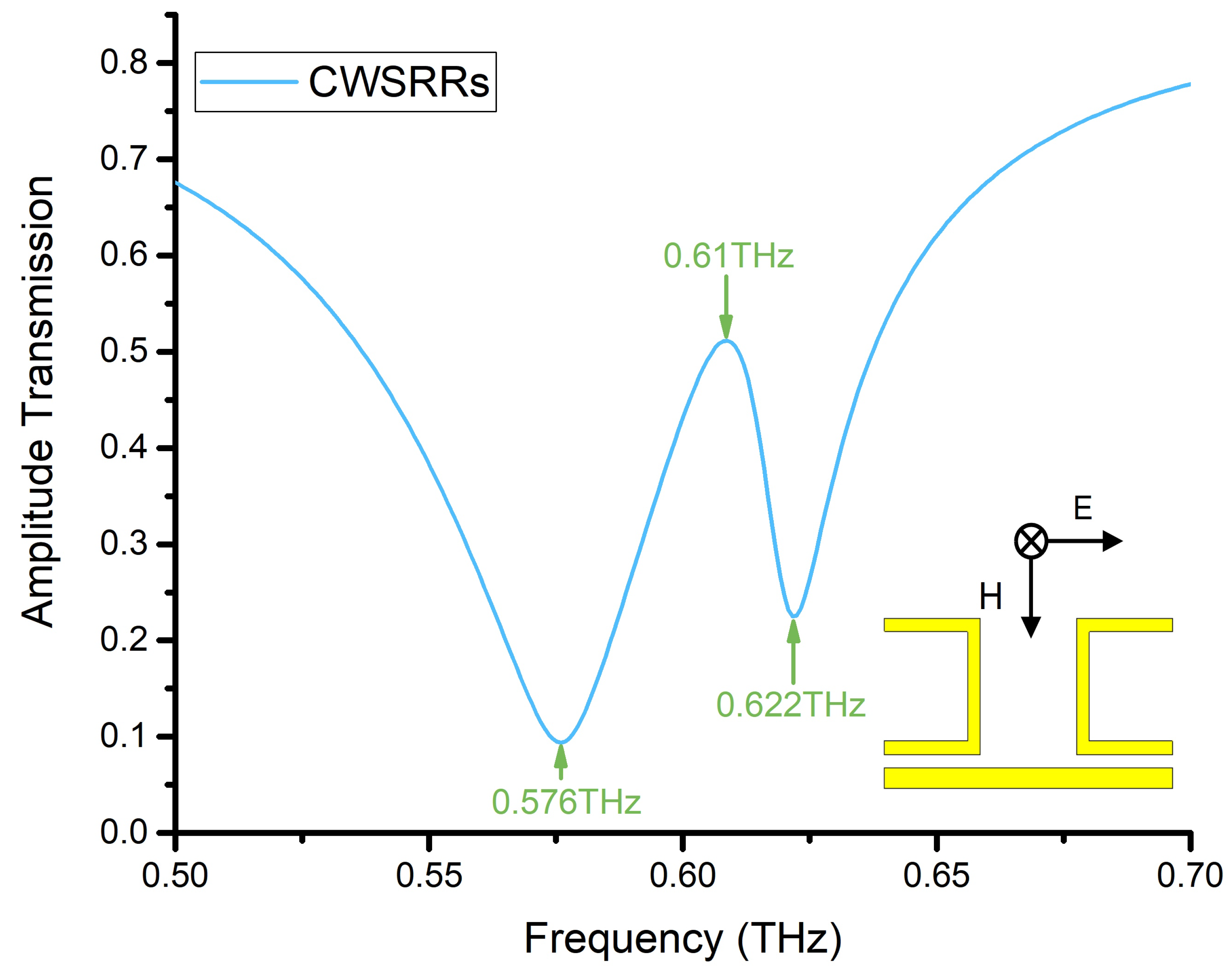
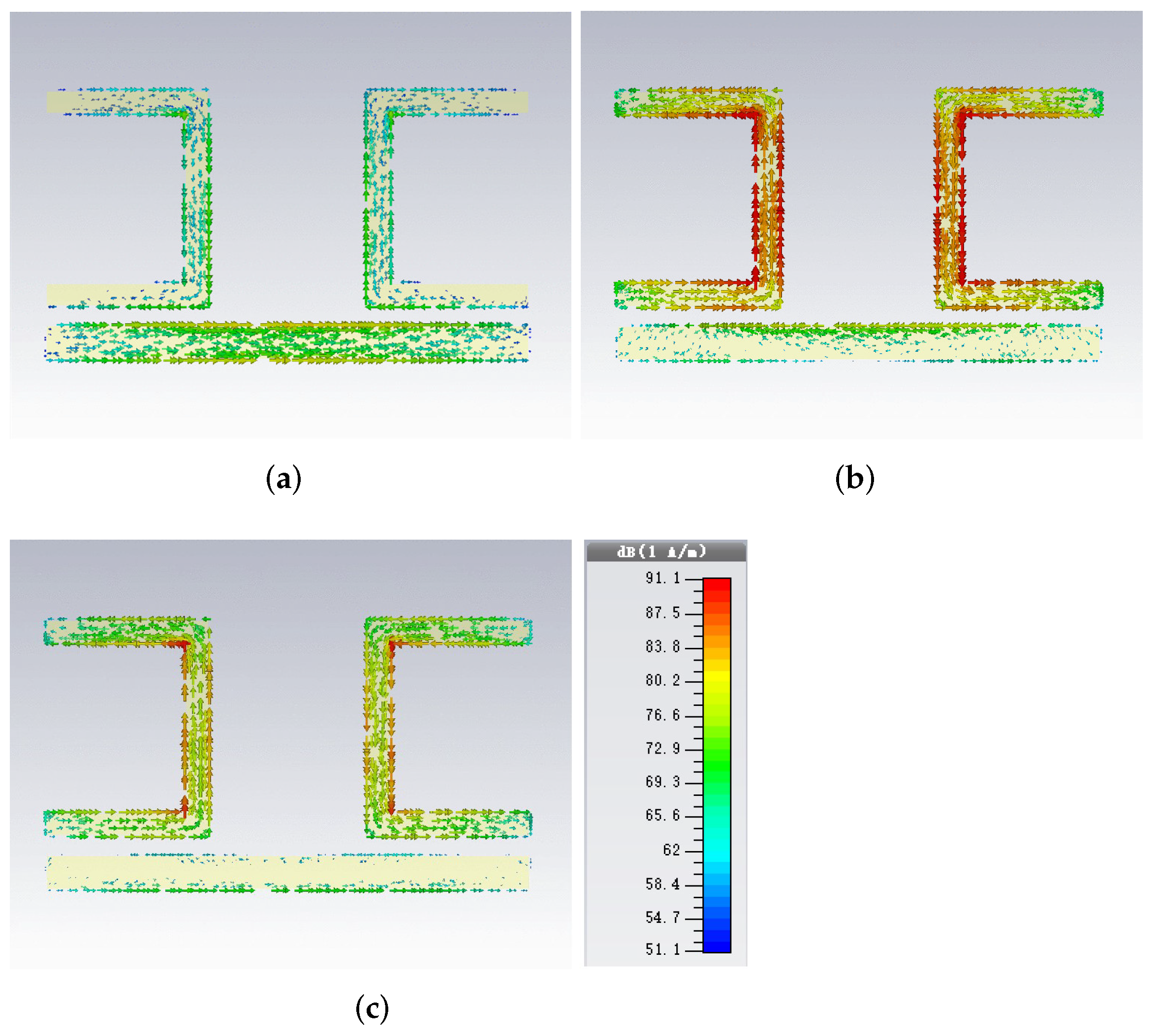


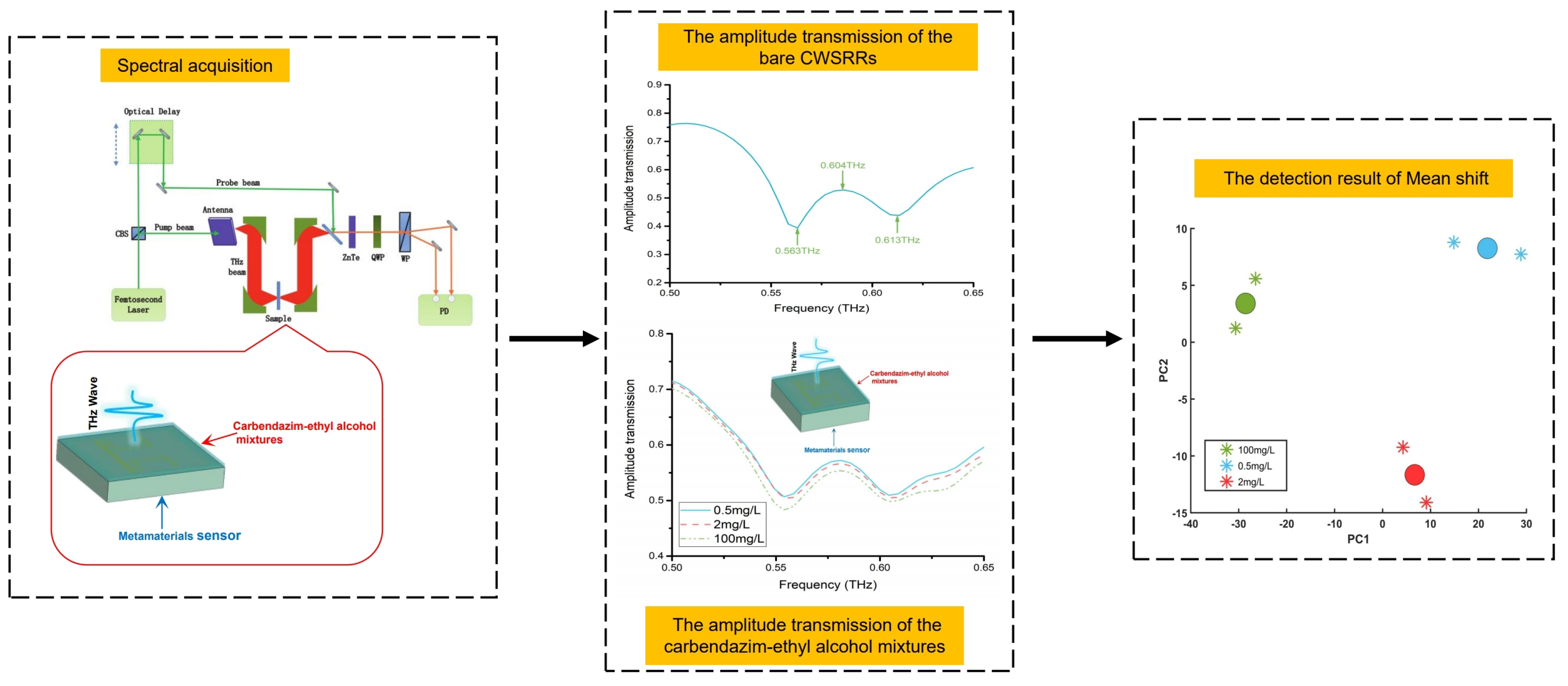
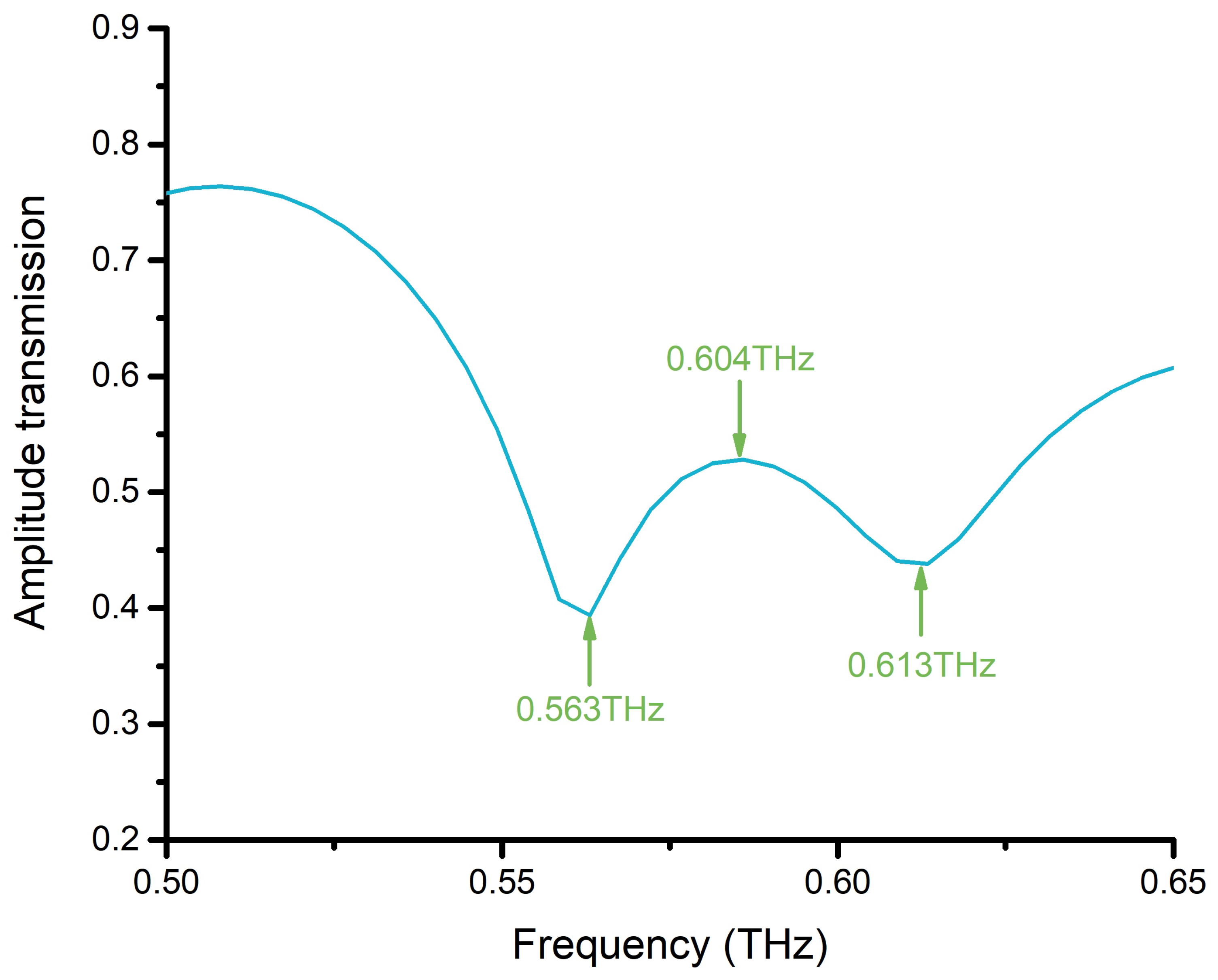
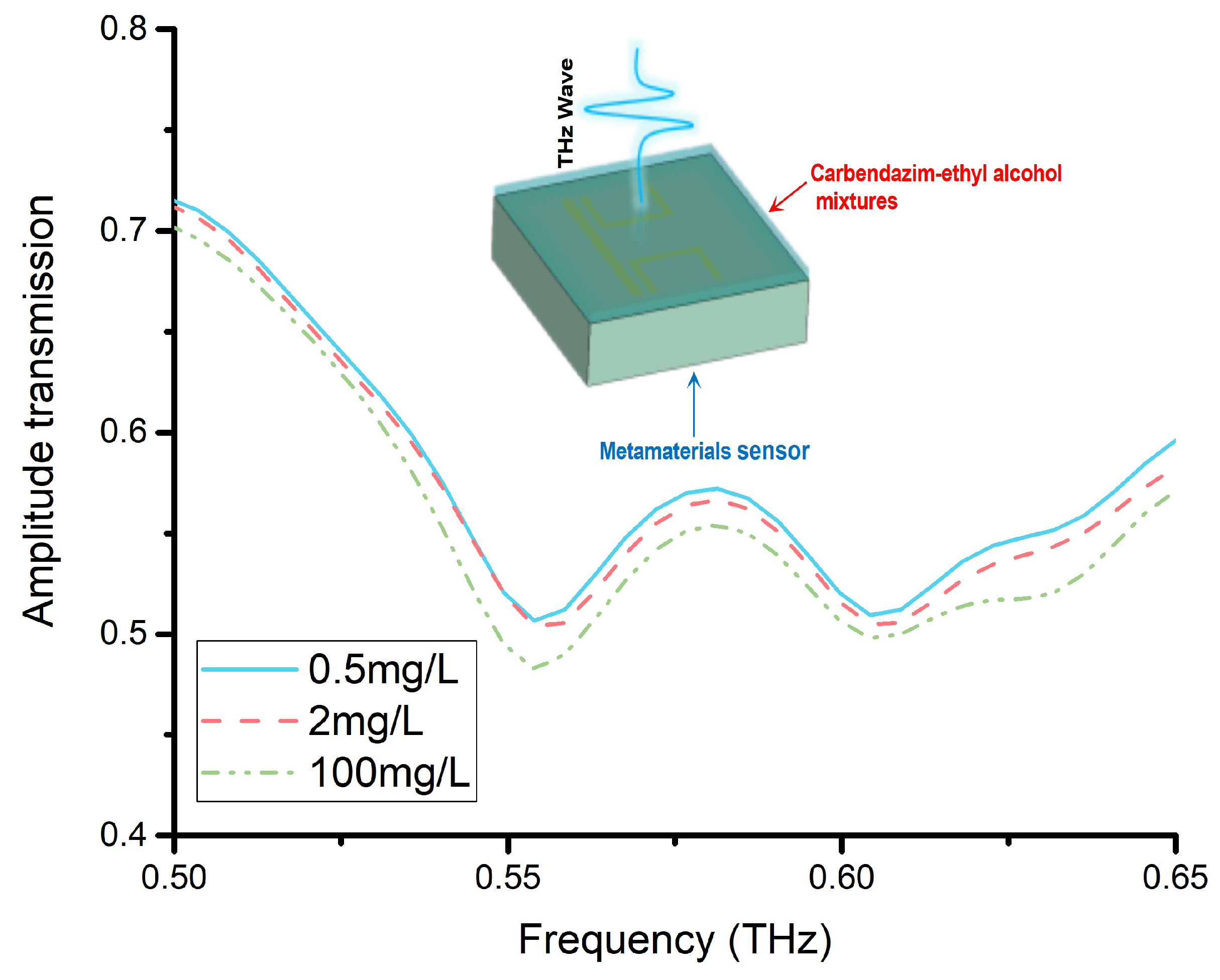
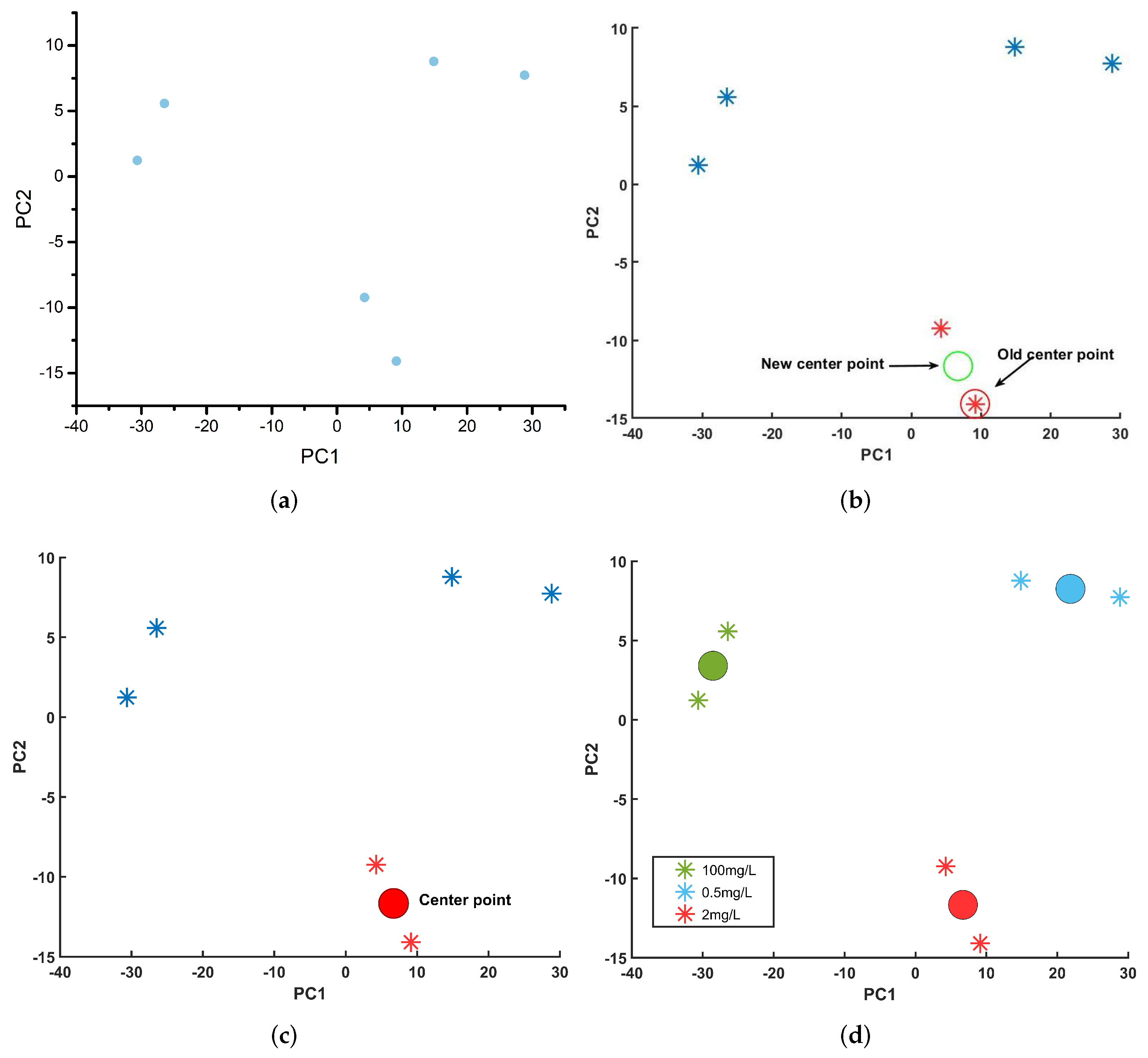
Publisher’s Note: MDPI stays neutral with regard to jurisdictional claims in published maps and institutional affiliations. |
© 2022 by the authors. Licensee MDPI, Basel, Switzerland. This article is an open access article distributed under the terms and conditions of the Creative Commons Attribution (CC BY) license (https://creativecommons.org/licenses/by/4.0/).
Share and Cite
Yang, R.; Li, Y.; Zheng, J.; Qiu, J.; Song, J.; Xu, F.; Qin, B. A Novel Method for Carbendazim High-Sensitivity Detection Based on the Combination of Metamaterial Sensor and Machine Learning. Materials 2022, 15, 6093. https://doi.org/10.3390/ma15176093
Yang R, Li Y, Zheng J, Qiu J, Song J, Xu F, Qin B. A Novel Method for Carbendazim High-Sensitivity Detection Based on the Combination of Metamaterial Sensor and Machine Learning. Materials. 2022; 15(17):6093. https://doi.org/10.3390/ma15176093
Chicago/Turabian StyleYang, Ruizhao, Yun Li, Jincun Zheng, Jie Qiu, Jinwen Song, Fengxia Xu, and Binyi Qin. 2022. "A Novel Method for Carbendazim High-Sensitivity Detection Based on the Combination of Metamaterial Sensor and Machine Learning" Materials 15, no. 17: 6093. https://doi.org/10.3390/ma15176093
APA StyleYang, R., Li, Y., Zheng, J., Qiu, J., Song, J., Xu, F., & Qin, B. (2022). A Novel Method for Carbendazim High-Sensitivity Detection Based on the Combination of Metamaterial Sensor and Machine Learning. Materials, 15(17), 6093. https://doi.org/10.3390/ma15176093






